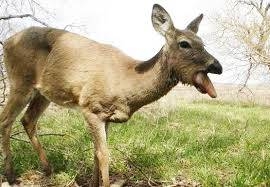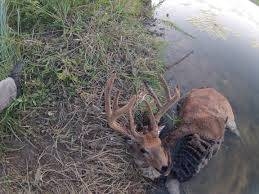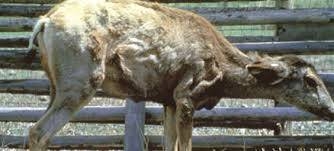
2 Photos
Unless you are new to the sport of Whitetail Deer hunting you have most likely heard of these 2 diseases
EHD -epizootic hemorrhagic disease & CWD- chronic waste disease
EHD-
Is a naturally occuring disease caused by a virus that is carried by a biting midge(culicoides,no-see-um).Once a deer has been bitten the symptoms which are swollen tongue, head or neck, severe fever and difficulty breathing may take up to a week to appear.
Afflicted deer will often seek out water to address the fever and if EHD has affected deer in your area you will most likely see dead or dying deer in or near water sources such as ponds, creeks & lakes.
EHD is more common in the Southeastern states of North America and DROUGHT plays a significant role. The midges breeding ground is found in the muddy areas that surround water sources and when there is a time of drought deer will congregate more often near these water sources and the midge can be more effective.
There is no current vaccine or cure for this disease, but don't be alarmed about this disease just be aware. EHD has caused no massive die off in the Whitetail Deer population.
There is no current scientific evidence that supports the spread of this disease from animal to animal or animal to human through contact, but if you suspect that a deer has died or is dying of this disease it should be reported to the VDGIF immediately. Do not attempt to contact, disturb or remove an animal suspected of having EHD.
It's also best not to ingest the meat of an infected deer for safety sake.
EHD typically occurs from mid August through October. The onset of freezing temperatures will stop the midge and cease the occurrence of EHD.
The perfect recipe for an EHD outbreak is a mild winter followed by a hot summer and a late summer drought, like Southwest Virginia experienced in 2007, 2012 and 2016.
The good news is that EHD to this point doesn't play a significant role in the Whitetail Deers population across our area in Virginia as well as North America. Not all deer die from EHD, often times a deer that is bitten will develop antibodies which will help them fight the disease in the future.
The only help we can provide as hunters is to keep the muddy areas around the water holes more vegitated and less muddy.
CWD-
Is a neurolgocal disease of deer/elk that is %100 fatal. The disease damages portions of the animals brain and typically causes progressive loss of body condition, behavioral changes and excessive salavation.There have only been 7 documented cases in Virgina to date and all these hunter- killed deer were from Frederick County. More than 130 cases have been found in neighboring West Virginia.
CWD kills less deer overall than EHD
Like EHD, CWD has no cure or vaccine
Deer can carry CWD for years with no symptoms and although it is not known exactly how it is transmitted it is believed to be passed in feces, urine or saliva. It is also believed to be more easliy passed where animals are congregated such as around water holes, feeders and in enclosures.
The movement of live animals is one of the greatest risk factors in spreading the disease into new areas. Natural movements of wild deer and elk contribute to the spread of the disease but, human-aided transportation of both captive and wild animals greatly exacebates the risk factor.
No scientific studies show a Whitetail Deer herd decline from CWD
CWD is unique to North America
There are no confirmed deaths of humans from handling or ingesting meat from an infected deer, but again always error on the side of caution.
No evidence suggests that CWD is a threat to livestock other than deer and elk and there have been no reported cases of CWD in dogs or cats.
Any deer/elk that is suspected of having CWD should be killed and immediately reported to the VDGIF.
THE BOTTOM LINE WITH BOTH DISEASES IS AWARENESS NOT PANIC.
Unless you are new to the sport of Whitetail Deer hunting you have most likely heard of these 2 diseases
EHD -epizootic hemorrhagic disease & CWD- chronic waste disease
EHD-
Is a naturally occuring disease caused by a virus that is carried by a biting midge(culicoides,no-see-um).Once a deer has been bitten the symptoms which are swollen tongue, head or neck, severe fever and difficulty breathing may take up to a week to appear.
Afflicted deer will often seek out water to address the fever and if EHD has affected deer in your area you will most likely see dead or dying deer in or near water sources such as ponds, creeks & lakes.
EHD is more common in the Southeastern states of North America and DROUGHT plays a significant role. The midges breeding ground is found in the muddy areas that surround water sources and when there is a time of drought deer will congregate more often near these water sources and the midge can be more effective.
There is no current vaccine or cure for this disease, but don't be alarmed about this disease just be aware. EHD has caused no massive die off in the Whitetail Deer population.
There is no current scientific evidence that supports the spread of this disease from animal to animal or animal to human through contact, but if you suspect that a deer has died or is dying of this disease it should be reported to the VDGIF immediately. Do not attempt to contact, disturb or remove an animal suspected of having EHD.
It's also best not to ingest the meat of an infected deer for safety sake.
EHD typically occurs from mid August through October. The onset of freezing temperatures will stop the midge and cease the occurrence of EHD.
The perfect recipe for an EHD outbreak is a mild winter followed by a hot summer and a late summer drought, like Southwest Virginia experienced in 2007, 2012 and 2016.
The good news is that EHD to this point doesn't play a significant role in the Whitetail Deers population across our area in Virginia as well as North America. Not all deer die from EHD, often times a deer that is bitten will develop antibodies which will help them fight the disease in the future.
The only help we can provide as hunters is to keep the muddy areas around the water holes more vegitated and less muddy.
CWD-
Is a neurolgocal disease of deer/elk that is %100 fatal. The disease damages portions of the animals brain and typically causes progressive loss of body condition, behavioral changes and excessive salavation.There have only been 7 documented cases in Virgina to date and all these hunter- killed deer were from Frederick County. More than 130 cases have been found in neighboring West Virginia.
CWD kills less deer overall than EHD
Like EHD, CWD has no cure or vaccine
Deer can carry CWD for years with no symptoms and although it is not known exactly how it is transmitted it is believed to be passed in feces, urine or saliva. It is also believed to be more easliy passed where animals are congregated such as around water holes, feeders and in enclosures.
The movement of live animals is one of the greatest risk factors in spreading the disease into new areas. Natural movements of wild deer and elk contribute to the spread of the disease but, human-aided transportation of both captive and wild animals greatly exacebates the risk factor.
No scientific studies show a Whitetail Deer herd decline from CWD
CWD is unique to North America
There are no confirmed deaths of humans from handling or ingesting meat from an infected deer, but again always error on the side of caution.
No evidence suggests that CWD is a threat to livestock other than deer and elk and there have been no reported cases of CWD in dogs or cats.
Any deer/elk that is suspected of having CWD should be killed and immediately reported to the VDGIF.
THE BOTTOM LINE WITH BOTH DISEASES IS AWARENESS NOT PANIC.
Unless you are new to the sport of Whitetail Deer hunting you have most likely heard of these 2 diseases
EHD -epizootic hemorrhagic disease & CWD- chronic waste disease
EHD-
Is a naturally occuring disease caused by a virus that is carried by a biting midge(culicoides,no-see-um).Once a deer has been bitten the symptoms which are swollen tongue, head or neck, severe fever and difficulty breathing may take up to a week to appear.
Afflicted deer will often seek out water to address the fever and if EHD has affected deer in your area you will most likely see dead or dying deer in or near water sources such as ponds, creeks & lakes.
EHD is more common in the Southeastern states of North America and DROUGHT plays a significant role. The midges breeding ground is found in the muddy areas that surround water sources and when there is a time of drought deer will congregate more often near these water sources and the midge can be more effective.
There is no current vaccine or cure for this disease, but don't be alarmed about this disease just be aware. EHD has caused no massive die off in the Whitetail Deer population.
There is no current scientific evidence that supports the spread of this disease from animal to animal or animal to human through contact, but if you suspect that a deer has died or is dying of this disease it should be reported to the VDGIF immediately. Do not attempt to contact, disturb or remove an animal suspected of having EHD.
It's also best not to ingest the meat of an infected deer for safety sake.
EHD typically occurs from mid August through October. The onset of freezing temperatures will stop the midge and cease the occurrence of EHD.
The perfect recipe for an EHD outbreak is a mild winter followed by a hot summer and a late summer drought, like Southwest Virginia experienced in 2007, 2012 and 2016.
The good news is that EHD to this point doesn't play a significant role in the Whitetail Deers population across our area in Virginia as well as North America. Not all deer die from EHD, often times a deer that is bitten will develop antibodies which will help them fight the disease in the future.
The only help we can provide as hunters is to keep the muddy areas around the water holes more vegitated and less muddy.
CWD-
Is a neurolgocal disease of deer/elk that is %100 fatal. The disease damages portions of the animals brain and typically causes progressive loss of body condition, behavioral changes and excessive salavation.There have only been 7 documented cases in Virgina to date and all these hunter- killed deer were from Frederick County. More than 130 cases have been found in neighboring West Virginia.
CWD kills less deer overall than EHD
Like EHD, CWD has no cure or vaccine
Deer can carry CWD for years with no symptoms and although it is not known exactly how it is transmitted it is believed to be passed in feces, urine or saliva. It is also believed to be more easliy passed where animals are congregated such as around water holes, feeders and in enclosures.
The movement of live animals is one of the greatest risk factors in spreading the disease into new areas. Natural movements of wild deer and elk contribute to the spread of the disease but, human-aided transportation of both captive and wild animals greatly exacebates the risk factor.
No scientific studies show a Whitetail Deer herd decline from CWD
CWD is unique to North America
There are no confirmed deaths of humans from handling or ingesting meat from an infected deer, but again always error on the side of caution.
No evidence suggests that CWD is a threat to livestock other than deer and elk and there have been no reported cases of CWD in dogs or cats.
Any deer/elk that is suspected of having CWD should be killed and immediately reported to the VDGIF.
THE BOTTOM LINE WITH BOTH DISEASES IS AWARENESS NOT PANIC.


